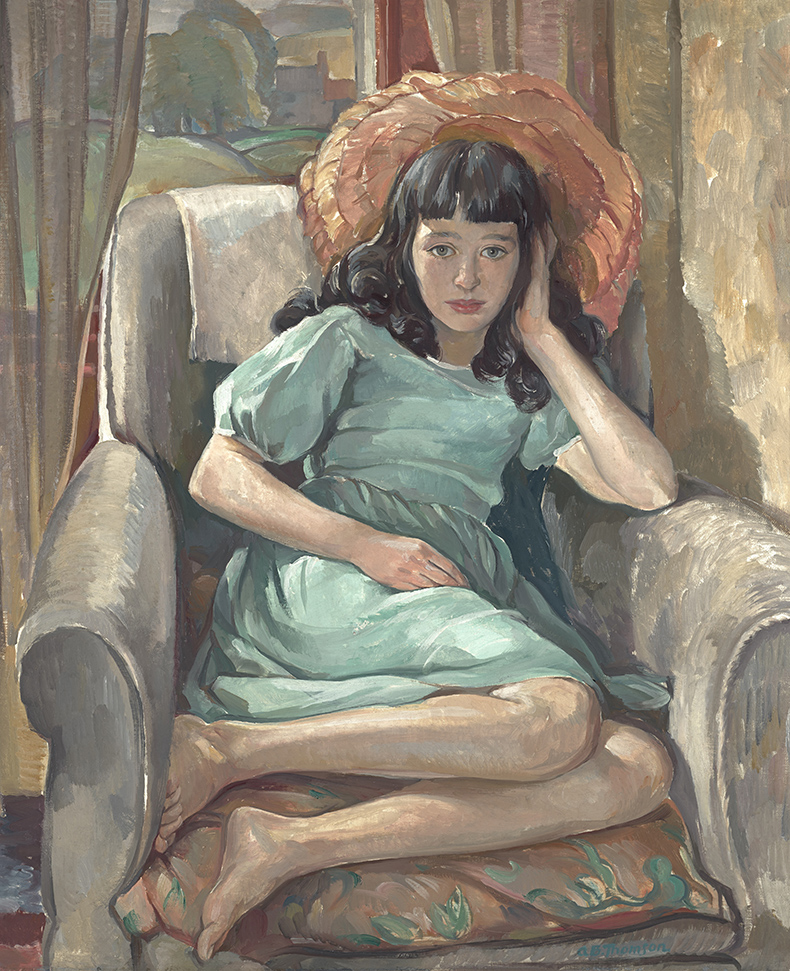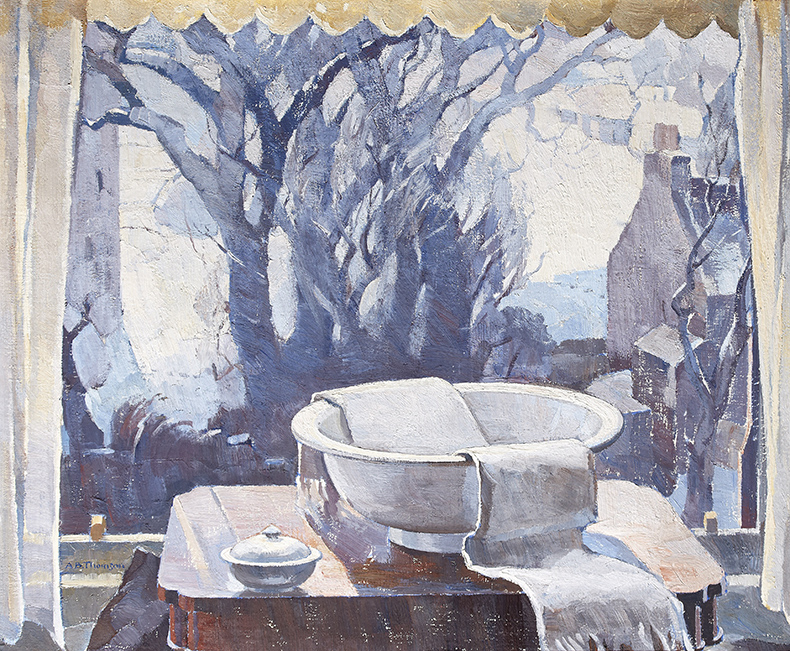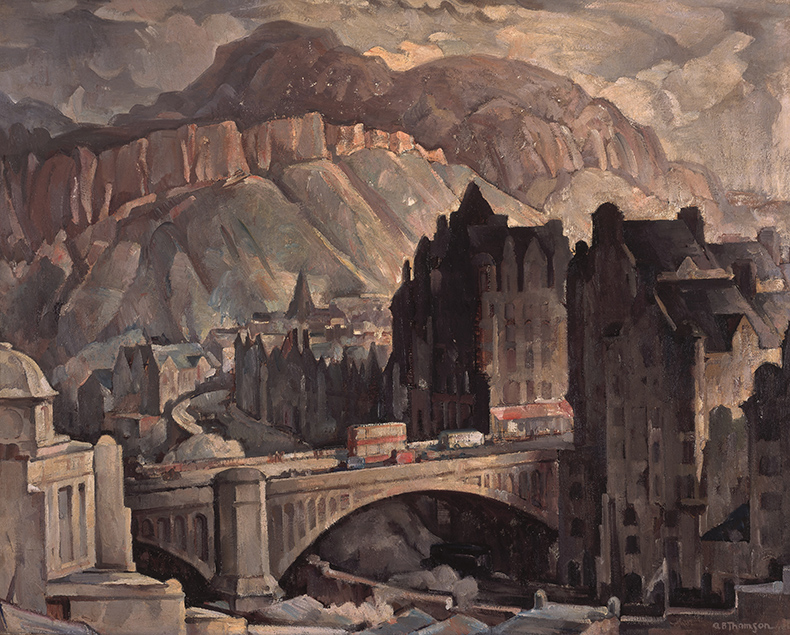This year’s Edinburgh Art Festival (EAF) invited viewers ‘to pause and reflect on the conditions under which we live, work, gather and resist’. I had one such moment of reflection at the press launch, when another critic questioned my decision to review the retrospective of the Edinburgh School painter Adam Bruce Thomson (1885–1976). This show was, they said, the kind of thing that would have happened anyway without needing to be under the umbrella of the festival.
It’s true that the City Art Centre’s show of Thomson’s works is at the more traditional end of the broad spectrum of exhibitions and events at the EAF, which this summer ranged from El Anatsui’s bottle-top tapestries at Talbot Rice to Prem Sahib’s re-working of a speech by Suella Braverman beneath Edinburgh Castle. Yet it would be hard to find an artist more relevant to living, working, gathering and resisting than Thomson, who was described as ‘a leading exponent of the contemporary point of view’ when he was, at long last, elected a member of the Royal Scottish Academy in 1946. ‘The Quiet Path’ attempts to rescue him from relative obscurity, compared to contemporaries such as William Crozier and William Geissler. The show displays not only Thomson’s accomplishment across printmaking, oils and watercolours, but also the impossibility of separating his shape-shifting career from the story of modern Scottish art.

Portrait of Mary (1936), Adam Bruce Thomson. Private collection. Photo: Antonia Reeve; © the artist’s estate
At the City Art Centre we are immediately confronted with the range of Thomson’s style across the decades. Church in the Valley (c. 1950) depicts the semi-rural landscape of the Edinburgh suburb of Colinton, its staccato trees and Cézanne-like brushstrokes lending the church architecture an organic complexion. It hangs here alongside Mary, a serene, naturalistic portrait from 1936 of the artist’s daughter in strikingly modern attire, and Loch Carron Shore (c. 1968), which gives us a taste of Thomson’s increasing abstraction – and perhaps less steady hand – in old age.
‘The Quiet Path’ is a narrative exhibition of the best kind, with captions that neither assume extensive knowledge nor condescend to the viewer and a brilliant catalogue by curator Helen Scott. Here we can follow Thomson’s development in parallel with that of Edinburgh’s artistic institutions. From 1903, he trained in architecture at the city’s Trustees’ School of Art, which had begun life as an academy of industrial design but gradually transitioned to artistic training. Reflecting the trajectory of the institution, he began classes in drawing and painting there too. He was still a student there when it merged with the art school of Heriot-Watt College (where he had previously taken evening classes) and the Royal Scottish Academy Life School to form the Edinburgh College of Art in 1906. Nearly a century later, the EAF would be formed out of a similar desire for coherence, aiming to create a greater profile for the city’s galleries in the August festival season.
Few other painters of the period could demonstrate so effectively the influence of international artistic currents on Scottish art. In New Galloway (c. 1922–25), we see a Cubist hint applied to a village landscape, but this influence is more apparent still in two paintings (absent from the exhibition because their whereabouts are unknown). Both The Cooling Towers (c. 1926) and The Stone Crushers (c. 1929) are industrial scenes set against striking landscapes and featuring human figures only very marginally; the natural world is to the fore even in Thomson’s most modern settings.
In the same decade, the artist produced From My Bedroom Window, a rather bleak still life of a wash stand seen against the backdrop of rather secretive trees and houses. It is even bleaker thanks to its positioning next to A Woman Washing Clothes (also mid 1920s), in which the human figure heightens the absence of any life other than trees in the former. A tough First World War, in which he served as an engineer in Arras and lost his closest friend, left Thomson preoccupied with melancholic military scenes, and understandably drawn to idyllic Scottish landscapes.

From my Bedroom Window (mid 1920s), Adam Bruce Thomson. City Art Centre, Edinburgh. © the artist’s estate.
In the 1930s, Thomson’s paintings retreat to a style closer to post-Impressionism, with a more liberal use of colour lending itself to works that both blend and contrast urban and rural landscapes. In North Bridge and Salisbury Crags, Edinburgh, from the North West (c. 1934) the brooding cityscape may be in the foreground, but viewer’s eye is drawn to the brilliantly lit hills behind, which are distinctly architectural in quality. The Old Dean Bridge (c. 1932) brings a touch of Venice to the suburbs of Edinburgh, yet the crumbling nature of its built environment emphasises the fragility, rather than the grandeur of human civilisation.
For all his stylistic shifts, Thomson could not escape being regarded as outmoded. His composition classes at Edinburgh College of Art were deemed ‘particularly dull’ by students demanding a shake-up of the conventions of art schooling in the late 1940s. But he continued to innovate in his own work, with Study for Harbour, St Abbs (c. 1946) prefiguring the sharp contours and playfulness with proportions now associated primarily with David Hockney. In his later years, former students such as Wilhelmina Barns-Graham, John Houston and Elizabeth Blackadder would gain recognition for their work, which was unmistakably steeped in the technical precision and genre-defying freedom of their teacher.

North Bridge and Salisbury Crags, from the North West (c.1934). City Art Centre, Edinburgh. © the artist’s estate.
‘Adam Bruce Thomson: The Quiet Path’, is at the City Art Centre, Edinburgh, until 6 October.














![Masterpiece [Re]discovery 2022. Photo: Ben Fisher Photography, courtesy of Masterpiece London](http://zephr.apollo-magazine.com/wp-content/uploads/2022/07/MPL2022_4263.jpg)
Suzanne Valadon’s shifting gaze